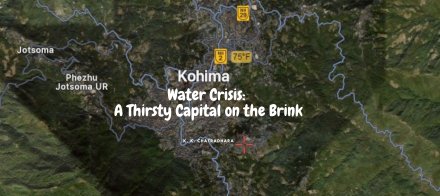 |
The people of Assam have many stories associated with water spirits and water deities, including the popular tales of Jalkonwar and Jalkonwari (water God and Goddess); they are worshipped by many as the guardians of the water bodies. The legend of Merbeel in upper Assam is perhaps the most interesting, as it is also intertwined with the mythical past of the Bareghar Satra, an Assamese Vaishnavite shrine in Dibrugarh district. In fact, the local residents claim, the present location of the Bareghar Satra – locally revered as ‘gosainbheti’ – amidst the watery surroundings of Merbeel, vouches for the veracity of popular lore about the origin of Merbeel.
The word, ‘mer beel’ suggests a vast water body that surrounds a patch of land, as in the case of an island. Located a few kilometres away from the Buri Dihing river, Merbeel almost encircles the Bareghar Satra, the domain of the mythical water deity of Jalkonwar, also known as the Kalika. The Burhi Dihing flows out of the Patkai hills of Arunachal Pradesh from the east and joins the southern bank of the Brahmaputra at Dihingmukh in the Sivasagar district of Assam. But how is the origin of Merbeel linked with the Bareghar Satra? Well, the story goes like this:
Once there was a big flood, which submerged a large part of the Bareghar Satra and its nearby villages. All the normal activities in the flood-hit villages came to a grinding halt. People were suffering and restless as they were stuck in their water-logged houses. Shri Ram Dev Gosain (holy man), the Satradhikar (head of the Satra), who used to live with his family, was trying hard to cope with the daily monotonous life at the Satra. One day, he was reciting the verses from the holy book, Kirtan. But his little daughter wanted his attention and was trying to climb onto his lap, repeatedly disrupting him. An annoyed Ram Dev Gosain asked his wife, Gosayani, to take the daughter away so that he could finish his reading. The Gosayani was quite busy with the domestic chores and failed to respond to the Gosain’s call immediately. The Gosain was quite upset by the child’s nuisance, and when the Gosayani showed up to take her daughter away, he, in a fit of rage, said: “Throw her into the water,” pointing toward the flooded courtyard. Taken aback by the Satradhikar’s sudden rage, the shell-shocked Gosiyani quickly picked her daughter up and rushed out of his room. The Gosain soon regained his composure and got engrossed in his Kirtan.
Within a few days, flood water receded and the village life returned to normal. Years passed by and the incident of that devastating flood was almost forgotten as the villagers got busy with their lives. Meanwhile, the Gosain’s daughter also grew up into a beautiful young woman and became a centre of attraction at the Satra.
One day, villagers from Merbeel Bhumuk near the Satra noticed an unusual event, which they had never encountered in their life. They saw a huge surge of water oozing out from beneath the ground, which soon turned into a big stream flowing in all directions. And within a few hours, the swelling water submerged all the villages, barring the Bareghar Satra. Where all this water came from, everybody wondered. After all, the monsoon had not yet arrived! That night Shri Ram Dev Gosain had a strange dream.
In the dream, Jalkonwar appeared before him and reminded him of his long forgotten angry outburst against his little daughter and his thought of throwing her into the flood water. “I heard everything you had asked your wife to do,” said Jalkonwar. “I gladly accepted your offer, but I decided not to take her with me then, as she was just a little girl. Now she is a young beautiful woman and I wish to marry her. So I have come to take her with me, seek your blessing, and fulfil your wish. If you failed to keep your word and refused to give your daughter to me, a catastrophic tragedy would befall the village and the entire area would perish under water.” Jalkonwar warned him with these stern words and disappeared.
A totally distraught Satradhikar woke up early the next day and called for an emergency meeting of all the Vaishnavs of the Satra. The Gosain narrated the whole dream, especially Jalkonwar’s demand of his daughter and the tragic consequences for failing to do so.
It’s a mere dream and an absurd demand, many pointed out while dismissing Jalkonwar’s unacceptable proposal. They urged the Satradhikar not to bother about the dream and ignore Jalkonwar’s warning in the dream. A few hours after they had left the meeting, people noticed that the water level was rising all over the area and was gradually approaching the Satra. Then everyone got scared. What now? Is the dream really coming true?
In the night, Jalkonwar once again appeared in the Satradhikar’s dream. Obviously Jalkonwar was upset. While reiterating his proposal, he commanded: “Tomorrow midnight the flood water will reach up to your courtyard to receive your daughter. She must be placed in the middle of the courtyard, adorably dressed in her exquisite bridal finery. Once she is brought out in the middle of the courtyard, there will be a sound of mangal uruli (joy). That will confirm that the wedding is complete. At that stage, some miracle will happen; the girl will remain hidden from public gaze.”
“Make sure that my wish is complied with as instructed. Otherwise, by the following morning, the entire area will be destroyed by the floodwater,” Jalkonwar cautioned and left.
The Satradhikar woke up, drenched in sweat; he was heartbroken as he informed the people of the imminent personal tragedy of losing his only daughter to Jalkonwar. “I will have to pay the price for committing a grave mistake, though unintended,” he said with a heavy heart. But he said he was prepared to sacrifice his daughter for the sake of the entire community.
According to the wish of Jalkonwar, the Satradhikar began to make necessary arrangements for the mid-night marriage. When the time came, the Gosain and Gosayani walked their daughter, draped in a beautiful bridal dress, up to the middle of the courtyard and offered her to the water. In the wink of an eye, the Gosain’s daughter disappeared, amidst the sounds of mangal uruli.
Soon after the wedding, water withdrew from all the areas, including at the source at Merbeel Bhumuk village. As a sign of his going back, Jalknowar left a trail filled with sand (balirbat) and tied two mango trees on either side of the sandy road. And both the mango trees were roped with mango leaves, usually done by the Assamese society during marriage when a bride enters the groom’s house.
It seems there are several versions of this lore. Some say, after the marriage, the Gosain’s daughter came to the Satra twice along with Jalkonwar, though no one saw them. After all, deities cannot be seen with naked human eyes! But one day, the Gosayani expressed her desire to see her son-in law, Jalkonwar, and asked her daughter to request him to show up.The daughter conveyed her mother’s wish to Jalknowar. He said, “If I showed my face once, your mother would not see me for the second time, and you too, would not be able to keep any relation with your parents.”
They agreed. Then immediately, the Gosayani saw a man with an elephant’s head, resembling Ganesha, the son of lord Shiva, on the floor of the Namghar (place for chanting Lord’s name). The Gosayani screamed in fear and shock. The neighbouring people heard her screams. But no one saw Jalknowar and Gosain’s daughter. The Gosaiyani later narrated this horrific incident to the Gosain. Since then, Jalknowar and his daughter never come to the Barghar Satra.
But, it is said, after this incident, a large water body emerged surrounding the Baraghar Satra, which came to be known as as ‘Merbeel’ (Mer means encirclement and beel means water body), and the village came to be known as ‘Merbeel Bhumuk’. Bhumuk was the place where the water first burst out from and turned into a flood.
This Merbeel and balirbat are still there, from where the Jalkonwar went back with the Gosain’s daughter. Even in modern time, the people of Assam consider Merbeel as an abode of the water deity and are careful of not polluting its water. And at one point in time, people were afraid of taking a bath in the deep waters of sacred Merbeel. It is also said that the water of the Bhumuk disappeared when people went to the place by saying, “Bhumukh Saboloi Jau (let’s go to see Bhumuk).” Still, people call the beel as Kalikalaga beel.
Merbeel has now become an attractive tourist destination with the setting up of what is known as the Merbil-Sasoni Eco-tourism Park. In February 2021, a tableau depicting the saga of Jalkonwar and his wife was installed inside the park and inaugurated during the Merbil Festival. The eco-park is said to have emerged as a favourite family outing site with food and lodging facilities, including fine camping opportunities around the greenery and the large water bodies that surround Merbeel. Locals claim that every year a large number of migratory birds visit the wetlands and that attracts many bird-watchers.
Geolocation is 27.314303632897683, 95.21116417989006


